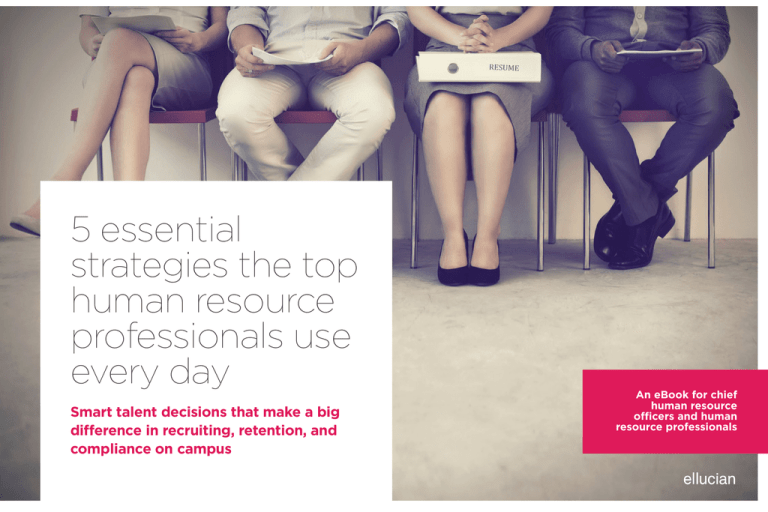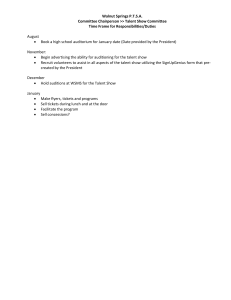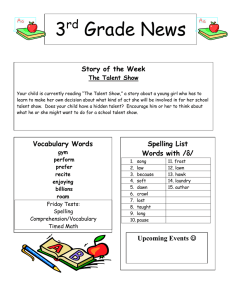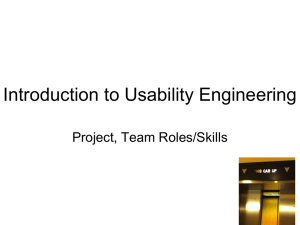
5 essential
strategies the top
human resource
professionals use
every day
Smart talent decisions that make a big
difference in recruiting, retention, and
compliance on campus
An eBook for chief
human resource
officers and human
resource professionals
CONTENTS
1
2
3
4
5
Introduction
Define what talent management means to your institution
Identify talent management priorities
Align talent management with strategic institutional goals and measure success
Improve succession planning efforts
Use technology to track and administer talent management initiatives
Conclusion
About Ellucian
Introduction
Since 1991, the number of students in higher
education nearly doubled to 20 million. As many
faculty members and staff approach retirement
age, institutions must recruit and develop new
professors, administrators, and staff in order to
maintain an acceptable student-to-faculty ratio.
To help, we’ve culled some information based on
results from the 2014 Workforce Talent Management
in Higher Education survey. This independent study,
conducted by the Human Capital Media Advisory
Group, which is the research arm of Workforce
magazine, in partnership with Cornerstone and
Ellucian, explored the function and scope of
academic human resources. The results help us
understand how human resource leaders view their
roles within the larger context of their academic
organizations and examine what processes colleges
and universities have in place to attract, train, and
retain employees and ensure academic compliance.
Here, we share five smart ways you can get ahead
of growing student populations while maintaining
teaching and operational performance.
3
4
1Define
what talent
management
means to your
institution
Outline the elements and scope of your talent management program
As you create your program, consider the full employee lifecycle. This helps you develop unified talent
management strategies that encompass each stage and understand how they affect your institution.
For example, think of all the ways the workforce is changing: who, how, what, where, and when. We now
have four or five generations in the workforce. Roles within organizations are shifting. And in this global,
mobile world, where employees physically work from is no longer relevant. With options like flexible
hours and shared jobs, the traditional 9–5 workday is a thing of the past.
So who owns talent management? More than half (53.38 percent) of survey respondents said that
talent management fell under the human resource department. But in 28.4 percent of institutions, that
responsibility fell to deans and department heads. The reality is that everyone at your institution plays a
role in making make sure that talent management efforts align with your institution’s overall goals.
Recruiting/talent acquisition
75.43%
Learning and development
75.09%
Employee management
48.44%
department. But in 28.4 percent of institutions, that
66.09%
Succession planning
33.22%
Leadership development
57.79%
Compensation management
33.91%
Compliance
0.00%
talent management fell under the human resource
responsibility fell to deans and department heads.
Performance management
Other
More than half of survey respondents said that
35.64%
4.84%
10.00%
20.00%
30.00%
40.00%
50.00%
60.00%
70.00%
80.00%
5
6
2 Identify talent
management
priorities
Determine your challenges
and build a strategy that helps
address them
According to survey respondents, recruiting
new employees (75.43 percent) and
providing learning and development for
existing employees (75.09 percent) were
the most important aspects of a talent
management strategy. And many institutions
have applicant tracking and leadership
development programs in place.
• Recruiting and talent acquisition
• Learning and development
• Performance management
Retaining talented
employees
43.3%
Developing employee skills
and competencies
44.3%
Managing employee
compliance and risk issues
52.9%
But there has been a fundamental shift in
what talent management means and what
it encompasses. We now realize it’s more
than just recruiting, it’s about retaining
The top three priorities
for human resource
professionals are:
What are the high/critical priorities in the talent
management area at your institution for the next
three years?
employees—and not just any employees,
the right employees. To identify and keep
high-performers in your organization, that
means expanding the scope to focus on
performance measurement and recognition,
Hiring the right
employees
0.0%
58.6%
10.0%
20.0% 30.0% 40.0% 50.0% 60.0% 70.0%
Figures from the U.S. Department of Education
show that faculty members have a median retention
rate of 11 years, meaning that every decade or so a
university needs to replace half its faculty.
succession planning, and appropriate
compensation.
Hiring the right employees, retaining talented
employees, and aligning talent management
with institutional effectiveness are critical
components of a holistic strategy.
7
8
3 Align talent
management
with strategic
institutional
goals and
measure
success
If you’re developing goals but not
measuring their effectiveness,
you’re just guessing.
Developing a talent management strategy is still
a work in progress for many—29 percent of the
institutions surveyed have a talent management
plan in place, 75 percent are in the process of
developing a plan, and 68 percent have no plan
at all.
accountable and tracking metrics are key to maintaining
compliance with board, local, state, and federal expectations
and laws. And as you know, compliance is key to
accreditation.
Unfortunately, even if an institution does have a talent
management program in place, almost half of the
institutions surveyed weren’t tracking their successes at
all. A comprehensive talent management solution provides
university leadership with the metrics and transparency they
Clear talent management goals that are aligned
with organizational goals can help ensure that
employees are working the right job, at the right
time, and moving the institution forward in a
targeted, meaningful way. So how do you know
We’re not currently measuring
success in talent management.
if you’re hitting the bull’s eye? Track and measure. Being
The talent management function is
currently well-aligned with the goals
of my institution.
need to make strategic decisions and track and report on
mandatory training for compliance. Detailed information
is essential to help institutions develop the compliance
strategies they need to meet requirements.
We’re not currently measuring
success in talent management.
Universities with 3,000–
10,000 employees
44.70%
42.90%
Universities with 3,000–
10,000 employees
44.70%
Universities with 10,000+
employees
Universities with 10,000+
employees
42.90%
Public universities
Public universities
4-year universities
All organizations
40.60%
38.60%
34.70%
49%
51%
The talent management fu
currently well-aligned with
of my institution.
40.60%
49%
51%
Agree
Disagree
4-year universities
All organizations
38.60%
34.70%
0.00% 10.00% 20.00% 30.00% 40.00% 50.00%
0.00% 10.00% 20.00% 30.00% 40.00% 50.00%
9
10
4 Improve
succession
planning
efforts
The workforce is aging, what are
you doing to bridge the gap?
Succession planning—identifying, selecting,
and grooming talent for leadership—is critical
to achieving your institution’s long-term
goals. Finding and developing leaders ensures
you’re always prepared for expected and
unexpected talent vacancies with a diverse
talent pool of ready successors. If you don’t
What percentage of your current
employees do you estimate will
retire in the next five years?
have a succession plan in place, how do you
know who you need to hire and when?
Smart succession planning gives you a
80.0%
competitive advantage, as it takes you beyond
simple replacement planning—a gamble of
talent and resources—to creating individuals
HIGH
qualified and ready to lead your institution
into the future. Maybe the right employee is
right under your nose.
17.4%
AVERAGE
You may not have to hire outside of your
organization if you have accurate information
on your top performers. Develop the talent
you have. The millennial generation moves
around and moves forward, so give them a
place to go. Training your existing employees
as part of your succession planning makes
sense down the road, too. In 2012, Matthew
Bidwell, an assistant professor at the
University of Pennsylvania’s Wharton School,
conducted a study and found that those hired
externally were 61 percent more likely to be
laid off or fired and 21 percent more likely
than internal hires to leave a job on their own
accord.
To ensure your institution does not face an
instructional knowledge gap when senior
faculty do retire:
• Identify high performers
• Offer mentor programs
• Map current skills
• Map needed skills
Although 60 percent of senior faculty members wanted to retire, there were compelling reasons
to keep working past age 65, such as fulfillment in their duties and a lack of retirement funds.
0.0%
—2011 TIAA-CREF study
LOW
11
12
5 Use
technology
to track and
administer
talent
management
initiatives
Make better decisions based on data
Here, a breakdown of what institutions are using:
A single unified
solution: 6.77%
Not tracking talent
management
functions at all:
29.7%
Hiring well, training employees, and ensuring their growth
and development in their respective fields are the top-level
goals for any talent management program. While some
organizations have modernized their talent management
processes, there is still room to make significant progress.
Multiple but
integrated systems:
17.29%
Manual solutions:
18.42%
Multiple,
unintegrated
tools: 27.82%
Siloed, manual systems lead to missed opportunities and
inaccurate information. Having the right data on faculty
and staff provides human resource professionals with the
insight they need to align talent management strategies with
institutional goals. A single, integrated system that automates
daily processes and boosts efficiency provides valuable insight
that helps you make decisions based on facts, not guesswork.
What type of technologies do you have in place to track and administer talent management initiatives?
We do not track or
administer talent
management functions today
“The market for top talent in higher
education is more competitive than
ever. We can’t simply let HR hire
new employees and then leave it at
that. We need a proactive strategy
to develop and retain our best
employees.”
—Linda Boyer-Owens | Associate Vice Chancellor, HR
and Organizational Development, Alamo Colleges
29.70%
We mostly use spreadsheets
and paper-based processes
for talent management
18.42%
We have several different
tools that are not integrated
27.82%
We use several different, but
integrated, tools to manage
different talent management
functions
17.29%
We have a single unified
solution that supports all
talent management functions
266 total respondents
7 skipped
6.77%
0
10
20
30
40
50
60
70
80
13
Conclusion
A unified talent management strategy encompasses multiple areas and spans the entire employee
lifecycle. Your plan should integrate talent management processes and technology into a single,
cohesive solution that helps you focus on business needs, alignment, and desired results.
The Ellucian Talent Management Suite, leveraging the industry-leading functionality developed by
Cornerstone, is customized to meet the unique needs of higher education professionals. Ellucian Talent
Management Suite delivers a powerful, secure set of cloud-based tools that can save you money
and is comprised of three modules that can be used together or individually depending on need: the
Recruiting module, the Learning module, and the Performance module.
Banner® Human Resources, part of the larger Banner® by Ellucian suite, is a comprehensive human
resources, payroll, and position control solution that helps institutions support every aspect of the
employee lifecycle.
Colleague® HR automates burdensome paper-based and administrative tasks, allowing HR staff to focus
on higher-value activities. Colleague HR empowers employees with self-service options for accessing
their own HR information. And it provides leaders with tools for predicting and planning for future staff
needs, including metrics on industry trends.
14
About Ellucian
Ellucian helps higher education institutions thrive in an open and dynamic world. We deliver
a broad portfolio of technology solutions, developed in collaboration with a global education
community, and provide strategic guidance to help education institutions of all kinds navigate
change, achieve greater transparency, and drive efficiencies. More than 2,400 institutions in 40
countries around the world look to Ellucian for the ideas and insights that will move education
forward, helping people everywhere discover their futures through learning.
To learn more, please visit www.ellucian.com.
Headquarters: 4375 Fair Lakes Court, Fairfax, Virginia 22033, USA
Phone: +1 800.223.7036
www.ellucian.com
© 2016 Ellucian, Inc. All rights reserved. EEB-522







